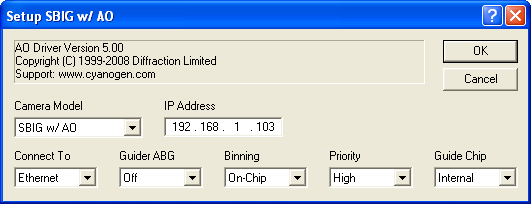
SBIG Camera with AO
For this driver, please select SBIG w /AO on the Setup tab.

When using an AO adaptive optics autoguiding accessory, set to SBIG w/ AO. If an SBIG filter wheel is connected via the camera, set the Filter selection to SBIG Universal. It will work with the AO-7, AO-8, AO-8T, AO-L, and AO-X adaptive optics units, and all USB/Ethernet cameras that support these devices. This includes the modern STT, STXL, and STX cameras, as well as the older ST-7 series and STL series cameras that have USB interfaces.
Usually the Autoguider is set to None, since the Guide tab is not normally used with the AO. You can however turn on Dual Chip Mode if you wish to use the Guide tab functions with the guide sensor when the AO is not running.
For Ethernet connection, select Ethernet and enter the correct IP Address for the camera. The IP Address is ignored when connecting to a USB camera. To connect to a camera using USB, simply select the camera name from the Connect To dropdown.
The Download Priority can be adjusted. Very High will ensure that no lines appear in the image due to readout delays, but may make it difficult to operate the mouse. Higher priority downloads may improve image quality on older cameras that do not have a built-in frame buffer.
Guider ABG affects the anti-blooming control for the autoguider CCD only (supported by older guide heads with TC-211 or TC-237 sensors only). Normally it is turned off. Anti-blooming for the main CCD is determined by the type of CCD chip installed in the camera.
Setting Binning Mode to Off-chip can be useful when a non-anti-blooming CCD chip is installed (older ST and STL models only). When enabled, it causes any binning to be performed after the CCD chip has been read (normally, binning is done inside the CCD chip before readout). Selecting this option results in slightly higher readout noise but reduces blooming. This control has no effect for anti-blooming CCD chips, and has no effect for 1:1 binning. You can also set Binning Mode to Spectroscopy. In this mode, the main sensor can be binned Nx1 to Nx3, where N ranges from 1 to 255.
The Guide Chip setting is used to select between the internal guide chip and the separate Remote Guide Head that is available as an option for many SBIG camera models. Select the Internal setting to use the guide chip that is built in to the main camera body. Select External Remote to use a separate "guide head".
Important Note: Some SBIG cameras contain interline CCD sensors that can be electronically shuttered, allowing them to achieve shorter exposures than frame-transfer chips, where the exposure duration is limited by the speed of the shutter. Unfortunately, the camera electronics behave differently for short exposures than for longer exposures, producing different bias patterns in the camera images. To successfully calibrate images from these cameras, bias frames cannot be used to calibrate images whose duration is shorter than .12s. These short duration images must be dark subtracted using a dark frame of the same duration as the light frame. Similarly, dark frames exposed for less than .12s cannot be scaled to match light exposures of a longer duration. For longer exposures, all of the calibration options work normally.
Please see SBIG AO Control for full details on operating an AO unit.
Availability of this feature depends on Product Level.